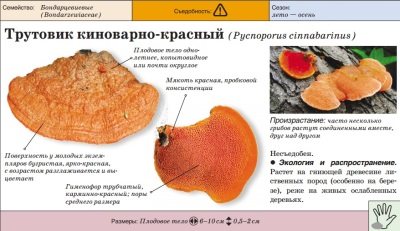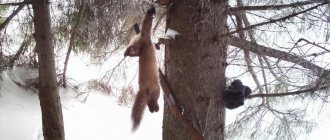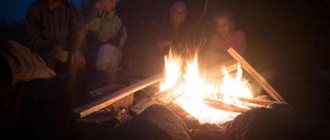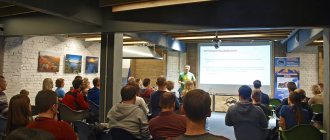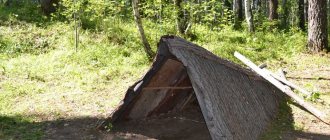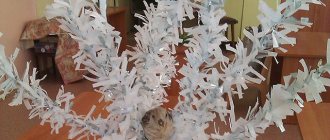How to find tinder
Polypore fungi usually grow on old rotten trees and stumps, but sometimes they can also infect young trees through damaged bark or broken branches. They break down dead wood, turning it into mineral compounds that enrich the soil. The shape of the fruiting bodies of polypores is round or hoof-shaped, the cap is uneven, as if it consists of rounded nodules. The color can vary: from almost white to dark gray, from beige to orange.
A real tinder fungus is easily separated from the trunk, unlike a false one, which is tightly attached to the wood.
Description of edible mushroom
The sulfur-yellow tinder fungus is an annual mushroom that belongs to the Letiporus family, order Polyporaceae. For its nutritional qualities, it was called Chicken Mushroom, Tree Chicken or Forest Crab; it is also popularly called Witches Sulfur or Kulyna.
The Latin name Laetiporus sulphureus comes from laetus - lovely, pleasant, abundant, fat; porus - time, opening; sulphureus - sulphurous, sulfurous.
At the beginning of development, the small mushroom is drop-shaped, has a delicate fleshy consistency, and the color can vary from intense yellow to orange. As the fruiting body grows, it hardens, and the pseudocaps of the mushroom become like ears, consisting of several fused fan-shaped processes growing from one base (rarely single). The edges are wavy, divided into segments with pronounced cracks, the surface is covered with a light fluff of light yellow color. The diameter of the cap ranges from 10 to 40 cm. Old specimens lose color and become gray-yellow. The mass of the mushroom reaches 10 kg.
The spore-bearing layer (hymenophore) on the lower surface of the cap is tubular, with round or jagged small pores 3–5 pcs. per mm. The tubes themselves are yellow, short, 2-4 mm long; in young mushrooms they secrete a yellow liquid.
The pulp of the young mushroom is soft, tender and juicy, white when cut.
The stem is absent, the pseudocaps grow directly from the tree trunk, their thickness at the base is about 7 cm.
A little history
The fungus was originally described in 1789 by French botanist and mycologist Jean Baptiste François (Pierre) Boulliard, and its modern name was given in 1920 by American scientist William Alphonso Murrill.
The benefits of tinder fungi
The medicinal properties of tinder fungus have long been known. It contains agaric, buricol, ricinol, fumaric, malic and citric acids, lanophil polysaccharide, glucose, phytosterol, monosaccharide and a large number of resins. In ancient times, tinder fungus was used as an external hemostatic property: thanks to its porous structure, it absorbed blood well, and its resinous substances disinfected wounds. An infusion of tinder fungus was used for pulmonary and colds. But most often, the dried mushroom (it was called tinder) was used to start a fire.
Nowadays, Japanese scientists have discovered that lanophil, contained in tinder fungus, stimulates the functioning of the liver of the bladder. This cleanses the bile ducts and destroys the fatty layer covering the liver. Polypore can be used for cirrhosis of the liver, hepatitis B and C, and biliary dyskinesia. Tinder fungus contains oncoprotective substances, so it is useful for cancer. Preparations from tinder fungus help to endure severe chemotherapy and radiation therapy.
An infusion of tinder fungus can be used to boost immunity. Grind the tinder fungus, pour a tablespoon of powder into 2 cups of hot water and heat for 40 minutes. in a water bath. Let it brew in a thermos for 4 hours and strain. Take a tablespoon 3-4 times a day 30 minutes before meals. Drink the decoction for 2 weeks, take a break and continue.
The tinder fungus can be crushed using a meat grinder.
But tinder has gained particular popularity as a remedy. Thanks to stimulation by lanofil, the liver breaks down fats better, and the enzymes included in the tinder fungus reduce appetite. To improve liver function, pour 0.5 teaspoon of ground tinder fungus into a glass of boiling water and leave in a water bath for 15 minutes. Drink the infusion in small sips throughout the day. To improve the taste, you can add a teaspoon of honey.
There is also a very simple one. Stir a level teaspoon of crushed tinder fungus into 1/2 cup of boiled water. Take 3 times a day 30-40 minutes before meals.
Despite the large number of types of fuel that people have learned to produce over the centuries, wood is still actively used. Wood and its waste - shavings, sawdust, wood chips - all this can be used to operate wood gas generators created by yourself.
"Spartak Moscow" (or simply "Spartak")
- Russian football club, one of the most popular Russian football clubs. 12-time champion of the USSR, 9-time champion of Russia, 10-time winner of the USSR Cup, 3-time winner of the Russian Cup, 6-time winner of the Commonwealth Champions Cup. Since Soviet times, the cliché “Spartak is the people’s team” has been widespread.
Story
Base
The predecessor of Spartak, the ISS, was founded on April 18, 1922 by athletes from the Moscow district of Krasnaya Presnya, at the suggestion of Ivan Artemyev. A group of enthusiasts, with Artemyev at the head, received permission to demolish several abandoned houses in the Presnenskaya outpost area for the subsequent construction of a stadium here. In 1922, the stands, fences, locker rooms and the field itself were already ready. At the same time, the reorganization of two physical education groups is taking place: the Russian Gymnastic Society (RGS) and the Physical Education Society of Presnensky Football (OFV).
They will be transformed into the Moscow Sports Circle (MSC). At the same time, the Starostin brothers (Nikolai, Alexander, Andrei and Peter) joined the team, with whom a huge part of the history of Spartak is connected. The name of the future team caused heated debate, and in the end they settled on a compromise option - “Moscow Sports Circle of the Krasnopresnensky District” (“MKS”), but a year later the club was renamed “Krasnaya Presnya”, as originally proposed by Artemyev. Until 1935, the team performed under the names “Krasnaya Presnya”, “Pishcheviki” and “Promkooperatsiya”.
Spartak’s predecessors competed in the Moscow Championship for the first year in class “B”, but having taken first place in both the spring and autumn tournaments, the team ended up in class “A”, a competition in which they immediately won. In total, in 1923-1935, the team won the Moscow championship four times, and five times became first in the “club standings” - a complex indicator that, in addition to game results, also took into account the performances of junior teams, statistical indicators, game discipline and the general work of the sports section. Another Moscow championship occurred in 1942, when, due to the war, all-Union championships were not held.
Period 1935-1954
On April 19, 1935, on the basis of the football team, a voluntary sports society of cooperative workers was created. The name “Spartak” for this society, as well as for its football team, was proposed by Nikolai Starostin in honor of the leader of the rebel Roman slaves, as a symbol of the struggle for freedom.
In 1936, the USSR football championship was formed, and Spartak began to compete in it. The first, spring, championship was won by Dynamo Moscow, and Spartak came third; in the fall, Spartak won, pushing Dynamo to second place. It was in those years that the irreconcilable rivalry between these teams began, which only intensified after the Starostin brothers were repressed in 1942 on the personal orders of Dynamo patron Lavrentiy Beria. The first coach of Spartak in the union championships was the Czech Antonin Fivebre, who had previously coached several famous European clubs, including Valencia, then in the second half of 1936 Mikhail Kozlov worked as head coach, who won the first union championship. In 1937, he was replaced by Konstantin Kvashnin, with whom Spartak won gold in 1938.
The course of the 1941 USSR Championship was interrupted by the Great Patriotic War. A Spartak match in Leningrad with local teammates was scheduled for June 22, but it did not take place. Soon many of the team's players were drafted into the army. Vladislav Zhmelkov served the entire war, team leader Ivan Filippov and head coach Pyotr Popov volunteered for the front, Anatoly Velichkin and Stepan Kustylkin died in battle. After the cancellation of the USSR championship, it was decided to hold the autumn Moscow championship and cup, but this championship was never completed due to the approach of German troops to the capital.
In March 1942, the Starostin brothers were arrested. In their absence, the team competed in the Moscow Championship, taking third place in the spring tournament and winning the autumn one.
Period 1954-1991
In the first post-war years, the team won the national cup twice, but was never a champion. In the 50s, the team constantly competed with Dynamo Moscow for the title. Starting in the 60s, the club began to lose ground to Dynamo Kyiv. The worst period in the club's history is considered to be the seventies, when the club left the major league for the only time in its history. Nevertheless, the team won one title in 1979. In the 80s, the team competed well with the people of Kiev and was the national champion twice. In the last USSR championship, Spartak were second.
Modern period
The last time Spartak won the Russian championship was in 2001. Even then, foreign players began to appear in the team in large numbers, many of whom, however, did not make it into the main squad and after some time were put up for transfer; at the same time, in the late 1990s - early 2000s, after various conflicts with Oleg Romantsev, leaders popular among fans, such as Ilya Tsymbalar, Valery Kechinov, Andrei Tikhonov, left the club. In 2002, Spartak dropped to third place, performed disastrously in the Champions League (losing all matches with a goal difference of 1-18), and the relationship between Oleg Romantsev and the club president Andrei Chervichenko, who he brought to Spartak, began to deteriorate. Chervichenko earned a sharply negative reputation among Spartak fans. By the summer of 2003, the confrontation had reached the point of public accusations in the press. On the eve of the final match for the national cup with Rostov, Romantsev issued a press statement in which he harshly criticized the club's management.
The match itself was won with a score of 1:0, and team captain Yegor Titov said: “We played for Oleg Ivanovich - and for him.” Despite the victory in the cup, five days later Romantsev was fired, and Andrei Chernyshov was invited in his place , who at that time held the position of coach of the Russian youth team; He stayed at Spartak for only three months, until September. The doctors who came with Chernyshov, without the knowledge of the players, gave some of them the prohibited drug bromantane in large doses, which was discovered during doping tests of those called up to the main and youth teams of Spartak. The scandal came to the surface after Chernyshov’s resignation, in November 2003; The sanctions were a one-year disqualification for Spartak captain Yegor Titov and a two-year disqualification for the doctor Artyom Katulin brought by Chernyshov.
At the same time, two other scandals related to Chervichenko’s management unfolded - around the transfers of Dmitry Sychev and Vladislav Vashchuk. At the end of the 2003 season, the team, which ended up only in 10th place, was coached by Vladimir Fedotov, and for the 2004 season the Italian specialist Nevio Scala was invited, who did not achieve successful results and left before the end of the Russian championship. Somewhat earlier (in the summer of 2004), Chervichenko also left the team. Skala's successor was Alexander Starkov (2004-2006), and since April 2006, Fedotov again. In 2007, Stanislav Cherchesov became the head coach of Spartak (during the season). Under Starkov, Fedotov, and Cherchesov, the team became silver medalists three times in a row.
On July 12, 2008, in the 13th round of the Russian championship, Spartak lost to CSKA Moscow for the first time in 17 Russian championships with a difference of 4 goals (5-1). For the first time in Russian history, Spartak allowed one of the opponents to score a hat-trick already in the first half - CSKA Brazilian forward Vagner Love was able to do this. As a result, Stanislav Cherchesov made one of the most controversial decisions, sending three leading players to the double (Egor Titov, Maxim Kalinichenko and Santos Mozart). As a result, on July 29, 2008, its legends: Titov (ex-captain and leader of the club) and Kalinichenko left the team as free agents (i.e., for free), which caused great public dissatisfaction.
On August 13, 2008, in the 3rd qualifying round of the UEFA Champions League, Spartak suffered another crushing defeat from its main rival, Dynamo Kyiv, on its home field 1-4. The new general director of the club, Valery Karpin, who replaced Sergei Shavlo in this post, promised to make a decision about the head coach. As a result, on August 14, Cherchesov was dismissed, and Igor Ledyakhov, who until that moment held the post of head coach of the Spartak youth team (Moscow), was appointed acting head coach. Under his leadership, Spartak drew twice in the Russian Championship (with Amkar and Dynamo Moscow) and in the return match of the Champions League qualifying round again lost to the Kiev team, and again with a score of 1-4.
The search for a new head coach led to the arrival of a young Danish specialist, Mikael Laudrup, to this post, known for his performances as a player for the Spanish Barcelona and the Danish national team. Under the leadership of the new coach, Spartak reached the group round of the UEFA Cup, but lost two of the first three matches (including in Moscow to the Dutch NEK, which won away in European competition for the first time in the last 15 years). The team finished the 2008 season in 8th place and did not make it to the Eurocups.
Symbolism and form
The traditional colors of Spartak are red and white, the classic uniform coloring is red T-shirts with a white transverse stripe on the chest, white shorts, red socks with a white stripe. This is where the team's nickname comes from - “red and white”. The emblem of the Spartak society since its formation in 1935 has been a red rhombus with a white border, invented by N.P. Starostin, with the letter “C” in the center, through which a white stripe passes. The football club played under the symbols of the society until 1998, when, in the process of corporatizing the team by Oleg Romantsev, difficulties arose with using the symbols of the organization to which football Spartak no longer belonged. As a result, a new emblem appeared - with a soccer ball inscribed in the “C” (the design of the letter also changed). In 2003, the emblem received its current form - with a gold star above the diamond in honor of the five Russian championships won (the team won the fifth championship in 1997, by 2003 it had 9 gold medals).
Club anthems
Official anthem
In the 2006-2007 seasons. The official anthem of FC “Spartak” was considered to be a song with words and music by the club’s press attache V. Shevchenko. However, with his departure from the team, the club's management announced a competition among fans to create a new official anthem for FC Spartak.
Moscow doesn’t believe in tears, and even more so in football. The answer on the field is short, like our signature pass! - Above us is a red and white flag and a distant spirit of victory. He sees everything, he knows everything, he inspires us.
Spartak, Spartak... We are united, invincible. Go ahead, Spartak... All of Russia is proud of you.
The fan believes in his only grandee. In spite of fate, you were given a victorious star, Covered with the proud title of “people's team”, You remember everything, you can do everything, you are the first forever.
Spartak, Spartak... We are united, invincible. Go ahead, Spartak... All of Russia is proud of you.
We will be together forever, so we will tear anyone apart. Spartacists, it would be an honor, but the meat will grow. There are millions of us for whom “Spartak” is not just a word. We see everything, we know everything. Forward, Spartak, Forward!
Spartak, Spartak... We are united, invincible. Go ahead, Spartak... All of Russia is proud of you.
The official anthem of the Spartak Moscow football club was first sounded in 2006 in Luzhniki, and was regularly played at all home matches of the club: before the start of the match and, in case of victory, at the end.
Unofficial anthem
Fans consider the unofficial anthem to be a remake of the song “My Dear Capital” (now the anthem of Moscow), which they have been performing in the stands for more than fifteen years, and which tells about the famous unequal fan clash of the late 80s that occurred in Kyiv after the Dynamo Kyiv - Spartak match " Moscow:
We will remember the harsh autumn, The city of Kyiv and the cool Makhach, When there were only three hundred of us, And almost the entire stadium was crests.
And the enemy will never achieve, So that your head bows, My dear capital, Our golden Spartak Moscow.
I love your quiet groves and bridges over your river, I love your Red Square and an unequal battle with the cops.
But the enemy will never achieve, So that your head bows, My dear capital, Our golden Spartak Moscow.
Nicknames
In addition to the “red-whites”, the Spartak team has another nickname - “meat”, which appeared at a time when the team was called “Pishcheviki” and represented the trade union of food industry workers. For a long time, this nickname was considered offensive and was used only by fans of other teams, but in the late 1990s - early 2000s it lost its negative connotation and turned into one of the self-names of Spartak players, although some fans do not like it at the moment. As a result of such changes, fans of other teams were forced to look for a new insult, and in the end they settled on “pigs”.
Bitter rivals
Throughout the history of Spartak, some teams were considered by its fans and management to be particularly important rivals:
- Dynamo (Moscow) - the rivalry began back in the 1930s, when both teams played leading roles in the young USSR championship. After the Starostin brothers were repressed by the NKVD, whose departmental team was Dynamo, the enmity became irreconcilable. According to the players’ recollections, Nikolai Petrovich Starostin once killed a fly in the locker room with the comment “Oooh, damn Dynamo!” After Dynamo's results began to deteriorate starting in the 1970s, the rivalry lost some of its intensity, but with the collapse of the USSR and the formation of the Russian Championship it intensified again.
- Dynamo (Kyiv) - rivalry on the football field began in the 1960s, when the Kiev team won the USSR championship for the first time. In addition, the extremely pragmatic game, instilled in Dynamo by Valery Lobanovsky for many years, was the direct opposite of the traditional, often adventurous, emphasis on attack for the Spartak team. However, relations between fans of the two teams remained peaceful until the 1980s, when, with the growth of nationalist sentiments in Ukraine, things quickly escalated to outright hatred. In 1987, after fans went to a match with Dynamo, when Muscovite fans were beaten by Kyiv fans at the station , a song was written that many consider the anthem of Spartak fans. In particular, it contains the lines “... I will not forget the harsh autumn, the city of Kiev and the cool Makhach, when there were only three hundred of us, and almost the entire stadium was crests.” After the teams began to play in different championships - Russia and Ukraine - and met It was only in the Commonwealth Cup and the Champions League that the feud lost its former relevance, but still persists.
- CSKA is the youngest rivalry. Despite the fact that there were tensions in Soviet times, open hostility began only with the formation of the Russian Championship, when the vacant position of Dynamo Kyiv needed to be filled with a new principled rival.
It is worth noting that almost all provincial teams approach matches with Spartak as special, and this situation persisted even in the early 2000s, when the team was going through a crisis and ceased to be the strongest club in the country.
Achievements
Team Achievements
Champion of Russia - 9 times (1992-1994, 1996-2001). Champion of the USSR - 12 times (autumn 1936, 1938, 1939, 1952, 1953, 1956, 1958, 1962, 1969, 1979, 1987, 1989). Winner of the USSR Cup - 10 times (1938, 1939, 1946, 1947, 1950, 1958, 1963, 1965, 1971, 1992). Winner of the Russian Cup - 3 times (1994, 1998, 2003). USSR Football Federation Cup - 1 time (1987) Moscow Champion - 5 times (spring 1923, spring 1924, autumn 1927, spring 1934, autumn 1942). Champion of Moscow in the club competition - 5 times (spring 1923, spring 1924, spring 1927, autumn 1929, spring 1929).
Achievements of Spartak players
Recognized as the best football player in the country:
Evgeny Lovchev - 1972. Rinat Dasaev - 1982. Fyodor Cherenkov - 1983 and 1989. Victor Onopko - 1994. Ilya Tsymbalar - 1995. Andrey Tikhonov - 1996. Dmitry Alenichev - 1997. Egor Titov - 1998 and 2000. Became the top scorer of the national championship: Georgy Glazkov - 1936. Leonid Rumyantsev - 1937. Nikita Simonyan - 1949, 1950, 1953. Anatoly Ilyin - 1954, 1958. Yuri Sevidov - 1962. Nikolai Osyanin - 1969. Georgy Yartsev - 1978. Yuri Gavrilov - 1983. Sergei Rodionov - 1989. Valery Shmarov - 1990. Roman Pavlyuchenko - 2006. Roman Pavlyuchenko - 2007. Rinat Dasaev was recognized as the best goalkeeper in the world - 1988.
Links
- Official website of FC Spartak Moscow
- Spartak Moscow. Official history 1922—2002 (“Material parts”)
- Website of the future stadium
- FC "Spartak" Moscow in Lentapedia
- Statistics of FC Spartak Moscow
- Official website of fans of FC Spartak Moscow
- Fan site of FC Spartak Moscow
- FC "Spartak" Moscow on Wikipedia
Advantages and disadvantages of a homemade gas generator
Using a gas generator is convenient and economical. If the device is made correctly, and all rules and regulations are followed during its creation, then it is necessary to load fuel very rarely. Thus, firewood can be loaded into the chamber only once a day, and if charcoal is used to operate the gas generator, then the firebox can be filled only once a decade.
Creating a gas generator is a rather exciting process, but also very labor-intensive. It will require special skills, patience and, of course, material investments from the master. However, in comparison with industrial devices, the cost of a homemade wood gas generator is several times less.
In addition, the operation of a device created with one’s own hands must be carefully monitored. Hot gas has a fairly high temperature, which makes the unit a fire hazard.
The advantages include the availability of wood fuel. After all, in addition to firewood and charcoal, you can use sawdust, shavings, chips and other cellulose-containing materials. But when using waste, you need to remember that the moisture content of the fuel must be acceptable for the unit to operate at maximum efficiency. If you plan to use wood to fire the gas generator, then it must be cut into small and approximately equal parts.
The disadvantages of a homemade gas generator include the fact that air is forced into the combustion chamber, and this requires electricity.
Arrival at the airport and transfer
At Antalya Airport, even before passport control, employees scan tourists with a thermal imager, shouting “Mask, mask!”, and ask them to stand in line with the officer according to the markings on the floor.
Photo: Irina Salamakhina
I didn’t see anyone being pulled out of the ranks of those arriving because of a suspicious temperature. But if this happens, then the “overheated” citizen will receive updated information for tourists traveling to Turkey, a free coronavirus test, according to the Association of Tour Operators of Russia. Did the test show a positive result? Well, then a Turkish hospital instead of the sea. By the way, standard insurance from a tour operator covers treatment for coronavirus, provided that there is a positive test and the disease is confirmed in a medical institution.
After passport control there is a line of hand sanitizers, opening the way to baggage claim. There are special partitions here, but still the battle for first places at the belt with suitcases is a life-or-death battle.
Masks are required on the bus to the hotel. There is no special seating arrangement so that passengers are located one row apart from each other. Before the trip, I read in reviews that now the transfer, as a rule, takes place without a guide. But he was present on our bus - and, of course, he sold excursions.
Principle of operation
When wood burns in the open air, heat is released. But with a small amount of oxygen, the tree does not so much burn as smolder. This releases not heat, but flammable gas. Gas generators for wood and sawdust operate on this gas.
When wood smolderes, many chemical substances are released, only some of which are flammable gases, and the rest only pollutes the environment. Therefore, when creating a gas generator, it is necessary to get rid of these harmful substances. In addition, the resulting gas mixture must be cooled.
In a factory, the process of converting wood into gas occurs in three stages:
- Burning wood with a small amount of oxygen.
- Primary cleaning of volatile particles using a cyclone filter.
- Secondary cleaning with a water filter.
A self-made generator works on a similar principle, although the device itself looks simpler and takes up less space.
Kresalo
Kresalo (from “kresat”, that is, “to cut fire”[1], “to hew stone”, “to chop with a flint flint”), also called kromsal (from “kromsat”, that is, “to cut”), rezal or cleaver. It is a piece of pyrophoric metal or alloy. When it hits the flint, small chips are cut out of the steel, and since the metal heats up significantly during cutting, the heated chips ignite, interacting with the oxygen contained in the air. The process is similar to grinding a metal object on a grindstone, where small iron shavings ignite in air, creating a shower of sparks.
Initially, iron was used as a pyrophoric metal. However, iron is a rather hard and inert material; it was difficult to create sparks with your hands. In the 20th century, chairs began to be made from mischmetals, the most common of which is currently ferrocerium - an alloy of cerium, iron, lanthanum and the sum of lanthanides.
- Ancient armchair
- Modern mischmetal lighter chairs
Materials for creating a gas generator
To make a wood gas generator you will need a lot of materials. Before starting work on its creation, you should carefully prepare everything you need:
- metal for the main components of the device. It must be able to withstand high temperatures;
- welding machine and electrodes;
- grate;
- spring for cover;
- heat-resistant gaskets for hatches and connections of individual parts of the unit.
Before you start producing a homemade gas generator, you should decide how you will use it: for transport or for home. In the first case, small size and light weight are priorities.
It is best to use stainless steel as the main material for creating a car gas generator. Despite the high cost, it has such advantages as strength and lightness.
You can make a large device for your home. To create it, you can use improvised or used materials, the cost of which is relatively low, and they are much easier to obtain.
How to make tinder?
To make it easier for yourself to start a fire in the forest, you can prepare in advance by making your own tinder in advance. Various materials can be used as tinder at home, such as:
- plexiglass
- plastic
- rubber
- paper
- burnt fabric
- other
The following natural materials can be used to make tinder:
- tinder fungus
- dry grass
- bumps
- pine needles
- bird's nests
- and much more
Plexiglas, plastic, rubber
Plexiglass, plastic and rubber cannot be called tinder, since they do not ignite from a spark, but these materials burn for a long time and produce a high temperature, which allows them to set fire to even damp firewood. It is best to cut plexiglass into small pieces and put it in your equipment just in case. It is better to take rubber from an old bicycle or car inner tube. It won’t take up much space, but will greatly facilitate the process of starting a fire.
Paper
Rough paper like newspaper doesn't work well as tinder. First you need to crumple it, make it soft and fluffy. After that you can tear it into pieces. Toilet paper works better as tinder. Roll it into a tight roller and it will be convenient to ignite it with a spark or other means.
cotton wool
On every trip you should have a first aid kit with you. To make tinder, you can take cotton wool from the first aid kit. You need to twist a roller out of it to get a good coal. Instead of cotton wool, you can use cotton pads in their pure form or pre-treated with paraffin. Such a disc will not be afraid of moisture and will always be ready for use.
Burnt cloth
Experienced tourists use burnt fabric or “burnt cloth” as tinder. This tinder must be prepared in advance. The zhzhenka is made from cotton fabric. To make tinder, the fabric must be burned. In the simplest version, you can set fire to the material and after a while extinguish it so that it burns a little. If you have foil on hand, you can wrap the fabric in it and heat it over the fire so that the fabric is slightly burned.
To make quality tinder from cotton fabric, we need a tightly sealed tin can and an open flame. A gas stove will also work, but be aware that there will be a lot of smoke.
- We tear off a small piece from the material.
- We roll it up so that air can pass freely between the layers of fabric (no need to twist it tightly).
- Place in a jar and close the lid tightly.
- Place the jar on the fire for about 15 minutes (as soon as the smoke stops coming out, the burner is ready).
- Let's check the result.
The treated fabric will become charcoal in color and will fall apart easily. The burnt juice should be stored in a dry, airtight container.
Tinder fungus, chaga (kombucha)
If there are birch trees nearby, then you can find several more types of tinder. Firstly, this is Chaga or as it is also called kombucha. It looks like a growth on a black birch tree. If you tear it off, it's brown inside. This inner part, if dried, ignites at the slightest spark. You can also make tea from chaga, but that's another story.
If you find a rotten fallen birch tree, you can use dry rotted wood as tinder, which also ignites and smolders well.
The third tinder that can be found on birch is the tinder fungus. Outwardly, it looks like half the cap of an ordinary mushroom, but without a stem. It is attached to the trunk only with the upper central part and tries to disguise itself as a birch tree. The flesh of the tinder fungus is dense, resembling a cork. The flesh along the edge of the mushroom is velvety. This velvety part, when dried, is also good tinder.
You can use various materials that you have at hand as tinder and kindling. Experiment, try different ways of starting a fire. Tell us what type of tinder you use? If the information was useful to you, share it on social networks.
Mandatory conditions for quickly and successfully providing yourself with fire in an emergency are the availability of sufficient tinder, kindling and fuel. Moreover, tinder is the first and most important component from this list.
Tinder is any material that can immediately ignite or smolder when exposed to sparks. The use of tinder is especially important when making fire using flint and from the Sun. Or using . Since ancient times the following have been used as tinder:
— The inner part of the birch tinder fungus, boiled in a solution of wood ash. — Dried moss. — Flax and cotton fibers. - Other.
In addition, you can use the following as tinder:
— Birch bark shavings, birch bark. - Wood dust, fluffy cotton wool. - Dry grass. - Bird fluff. - Paper. - cotton fabric. - Napkins, newspaper and so on.
The main requirement for tinder made from any material is to be dry and flammable. Therefore, it is preferable to store tinder in a waterproof, sealed container. Although there are many natural materials that can serve as tinder, it is advisable to prepare it in advance and put it in yours. Because finding something suitable for use as tinder locally is not always possible. And if there is, it may be too wet.
If there is no great desire or opportunity to prepare tinder yourself at home, then it (or its substitute) can be bought in specialized stores. Such tinder has no particular advantage over homemade ones, except for the advantage that you don’t have to spend time making it. The video below shows WetFire Tinder dry tinder and Tinder Quik Firestarter.
You can make fairly reliable and high-quality tinder yourself. The simplest option is cotton wool tightly compacted into an 8-10 cm piece of tube from the blood transfusion system. One end of the tube is sealed tightly, and the other is closed with a plug made from elements of the same system. This tube container is sealed, very convenient to use and takes up minimal space. If necessary, just pull out the plug, cut off the required size piece of the tube along with the cotton wool, close the remaining tube with the plug, push the cotton wool out of the cut piece and set it on fire.
A more advanced version of tinder is cotton-vaseline balls, described by Cody Lundin in his book 98.6 Degrees: The Art of Keeping Your Ass Alive! To make them, you need to apply and rub Vaseline on the outside of cotton balls made of 100% cotton (not synthetic ones, which do not burn), leaving the middle dry. The finished balls will be packed accordingly in some kind of waterproof container.
To make a fire, you need to unfold such a ball, revealing its dry middle, and set it on fire with a spark from. The burning time of a cotton-vaseline ball with a diameter of 1-1.5 cm is about four to five minutes. Such balls can be stored without losing their properties for years, and Vaseline applied to them can, if necessary, be used as a moisturizer (chapped lips, etc.) or lubricant (for equipment).
Let's say you went outdoors or on a hike and are completely sure that you are equipped with everything you need. Unfortunately, you discover that you forgot your matches! Learning how to make fire using friction can save your life in an extreme survival situation.
This article provides a detailed description of one of the most interesting and complex methods of making fire using a bow spindle (“Indian fiddle”).
Preparation
- Find tinder
. As a rule, these are dry, fibrous materials that are flammable from a spark (lint from clothing, bird plumage, thin wood shavings, dry moss, crushed fibers of dry plants, the inner layer of cedar, birch bark, spruce cones, pine needles, tinder fungi, burnt cotton and linen, wax paper, dust produced by wood-boring insects) - Kindling and fuel.
- Gather a few handfuls of kindling. Long, dry rods about the thickness of a toothpick are best. Gradually increase the rods to pencil thickness.
- Use wood as fuel. They burn well, give a lot of heat and smolder for a long time. Soft conifers burn quickly and produce a lot of sparks.
- Try to avoid wood lying on the ground (it will most likely be damp or damp). Instead, collect firewood and kindling from dead wood. Look for dead branches that are tangled in bushes or the understory of trees. It should be noted that mixed dry and wet wood burns for a long time, and the smoke released from the wet wood will drive away insects.
- Make a "nest" for coal
. Wrap the tinder bundle in a denser material such as dry grass or leaves. Make sure you leave a recess for the charcoal and small gaps for ventilation. - a bow
from flexible, elastic wood (hazel, bamboo) . - Wooden plank
. For making boards, those that do not contain juice are best suited. Choose a light, dry tree and shape it according to the following dimensions: thickness - 2-3 cm, width - 5-8 cm, length - at least 30 centimeters. - the spindle (drill)
from hard wood that does not contain resins or other juices. However, you can use the same wood as for the board. The main thing is that the wood is dry and light. - Find or make a top support for the spindle. may be made of wood, bone or stone.
- Prepare the ember collector
. To insulate from the cold ground and move the coals into a pre-prepared nest with tinder, you can use a dry leaf, a wood chip, bark, a piece of paper, etc.
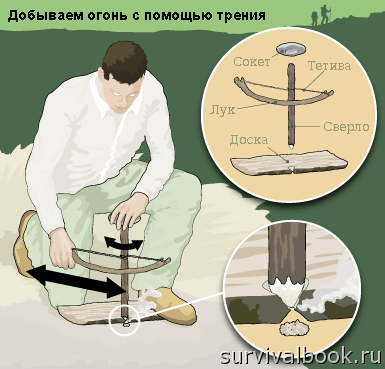
Making fire
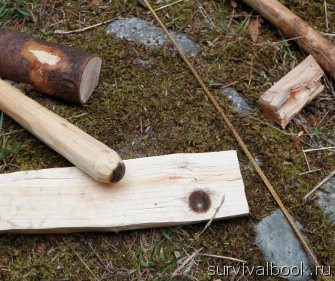
Voila! Now you can warm up and relax near the long-awaited fire...
Possible problems and their solutions
- Practice. Practice at home in your free time to develop experience and habit.
- If you get a good hot coal, the tinder will literally burst into flames in your hands, so always prepare kindling and wood for the fire in advance.
- The shape of the chimney is important, but not essential, provided it is slightly wider at the bottom than at the top. It is recommended to use a narrow chimney with a cut angle of about 60 degrees (1/6 of the pie) and a U-shape
, but V-cuts work too. The chimney is where hot wood powder is collected and mixed with air, allowing it to turn into coals. A wider chimney usually means you'll have to create more tinder (hot wood powder), but it will also allow for more airflow. - Maintain the position of the bow relative to the middle of the spindle. If the string moves closer to one end of the drill, a torque imbalance will occur and the drill will likely pop out of the socket (support block) or hole in the board. To return the string to its original place, change the angle of the bow as you move back and forth. The string should always be parallel to the ground and perpendicular to the drill. Never point the tip of the bow at the ground or sky. Learn to control the bow in a horizontal plane.
- The hole in the board and the tip of the spindle that goes into it should be rough
, not shiny and smooth.
Roughness increases friction. If they become smooth, pour some sand into the hole
. This is an old Indian trick that many settlers lost sight of. - If you're tired, don't be afraid to take short breaks. The process of making fire using the bow spindle method takes a lot of energy, unless you are one of those people for whom this activity is natural and everyday. If so, then you're in luck. For the rest of us, rest breaks can mean the difference between a warm, cozy night in the friendly surroundings of the forest and a cold, dark night in an inhospitable wilderness environment. Try to almost completely fill the chimney cutout with dark wood dust, and then take a break or pass the baton to your partner while the sawdust is still wet.
- If you have two people, you can act in tandem. The first person remains in charge (or leading) and sets the pace of work, while the second person adds effort to each movement. Such cooperation greatly facilitates the extraction of smoldering embers, especially in the first couples.
- It has been found that it is easier to work if your hands are a little sticky (like resin).
- Place the tinder nest under the chimney opening and you won't have to risk moving the coals. This technique will significantly reduce your effort.
- If you know you'll have to make a fire this way and don't have a flashlight, make sure you allow plenty of time for this procedure before nightfall. Experienced campers have been doing this for years and still have difficulty working in the dark. Even if you have a flashlight, do this during daylight hours. You'll be glad you did.
- Do not allow the board to wobble while drilling.
Warnings
- The spindle, board and socket become very hot.
- This method of making fire does not always work and takes a lot of time and effort.
- If you no longer need a fire, cover the ashes and make sure they do not pose an environmental hazard.
- Be very careful about what wood/leaves/branches you burn. For example, it is very poisonous, so make sure you do not use it as fuel. Do some research so you know what you can (and can't) burn in advance.
Manufacturing of wood gas generator
It is impossible to create a gas generator at home the same as in a factory. But this is not necessary. You can find a diagram for making a homemade unit from friends who already use such a device, or on the Internet.
First of all, it is necessary to make the main elements of the unit:
- frame;
- fuel bunker (loading chamber);
- air distribution and filter units;
- combustion chamber and its neck;
- grate;
- doors.
The body is usually made in a cubic or cylindrical shape. For these purposes, a container of a suitable shape is used, for example, a barrel made of durable metal, an empty household gas cylinder, and the body can also be made independently from a metal sheet. The loading chamber, like the body, can be made from improvised materials or welded from sheet metal. This unit fits inside the housing, so its dimensions must be smaller. The ideal metal for a fuel tank is carbon steel.
The housing must be equipped with a tight-fitting lid. One of the important conditions for operating a gas generator on wood and sawdust is its sealing, since the device requires a limited supply of air to operate. The lid is usually heavy, making it difficult to lift. To make the device easier to use, you can install a shock-absorbing spring on the cover.
To make the homemade unit stable, metal legs should be welded at the bottom of the body.
In the combustion chamber, the temperature reaches its maximum value. To make the combustion chamber in a home gas generator, you can use heat-resistant steel or an empty gas cylinder. If the cylinder previously contained household gas, then to prevent its remains from catching fire during welding work, the container should be filled with water before use. A cast iron grate must be installed in the combustion chamber. To facilitate the cleaning process, the grate is made removable or simply movable.
The head of the combustion chamber is separated from the remaining components using heat-resistant gaskets. Asbestos is quite suitable for such gaskets, but it is best to spend money and purchase modern materials.
After the combustion chamber, a filter unit is installed, where the resulting gas mixture is cleaned of unnecessary impurities and contaminants. The gas mixture is supplied to the filters through a pipe installed at the bottom. A cyclone filter can be made from sheet metal, the body of an old fire extinguisher, or another container of suitable size and shape.
A cooler is installed after the filter unit. For these purposes, you can use a regular radiator or make a coil. To speed up the cooling process, you can use water as a coolant.
The air distribution unit regulates the supply of oxygen to the fuel and also prevents the leakage of the resulting flammable gas. This unit is connected to the structure using a fitting and is equipped with a check valve.
All doors through which access to various components of the device are provided must be sealed. For this purpose, seals and gaskets made of heat-resistant materials are used.
Hotel
This is the most voluminous section, because the main restrictions and changes in the current situation in Turkey affected the hotel business.
Firstly, not all hotels are open. That is, they did not close forever, but simply decided not to accept guests during this dubious season.
Secondly, those hotels that wish to resume work, the Turkish Ministry of Tourism obliges Tourism in Turkey - with “health certificates”: as the Turkish minister spoke about, receive a “health certificate”. This is an official document confirming that the hotel regularly maintains all safety standards: from providing staff with masks and gloves to total disinfection of everything. The verdict is made by a commission, inspections are carried out every month. You can see whether the hotel has a certificate on a special page on the website of the Ministry of Tourism.
Thirdly, room occupancy is suffering - not all vacationers are ready to take an all-inclusive flight with the opening of borders. Hoteliers have to adapt to the situation, and they do this in not always honest ways: for example, by significantly reducing the variety of food on an all-inclusive basis or - a tourist's nightmare - replacing packaged juices with drinks diluted from powder.
An important point: everything described below applies to the place where I vacationed - the five-star Barut Acanthus & Cennet in Side. In other hotels it may be different, but here everything was as it should be in a hotel, adjusted for the pandemic. I felt safe here.
Check-in
From the moment you get off the bus until you check out, you won’t find a single employee at the hotel without a mask. It doesn't matter if it's a room cleaner or a lifeguard on the beach, all staff are packed in personal protective equipment.
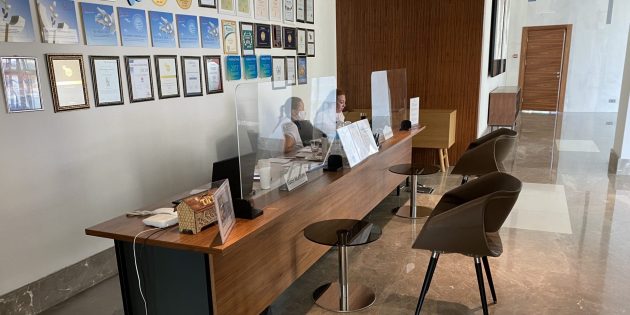
Photo: Irina Salamakhina
The check-in process for guests was “complicated” by literally several points:
- Before entering, tourists have their temperature taken with an infrared thermometer. Apparently, there is only one device for the entire hotel, because no one else threatened me with it.
- The managers at the reception are now separated from the guests by glass, it’s hard to hear each other.
- You need to fill out - with a disposable pen - another questionnaire asking if you have had coronavirus and where you have been in the last 14 days.
- Luggage is taken away for disinfection (carry-on luggage is not).
Numbers
“What could have changed in the rooms?” — I thought before the trip. And what was found!
Before the next guest moves in, the rooms are cleaned even more thoroughly and with disinfectants. TV remote control and toothbrush cups, for example, are processed and placed in plastic bags. Like, don't be afraid, disinfected. Antimicrobial wipes are left on the shelf - both in individual packages and in a common pack.
From time to time, an employee runs along the corridor with a rag: wiping door handles, railings, and buttons in the elevator. Such little things are reassuring - it is clear that the hotel takes the new requirements seriously.
Nutrition
Guys, the buffet has disappeared as a species! For a while, I suppose. But who knows, maybe the new system will take root? I liked her very much.
Imagine a typical buffet in a Turkish hotel. And place numerous shared platters of food, as well as empty plates, under the glass box. Touching is prohibited! Place an employee next to you wearing a mask and gloves - he is the only one who touches the food and puts on the plate what you point at. There is no limit to the amount you can add, but this is where Russian tourists will finally have to learn numerals in English.
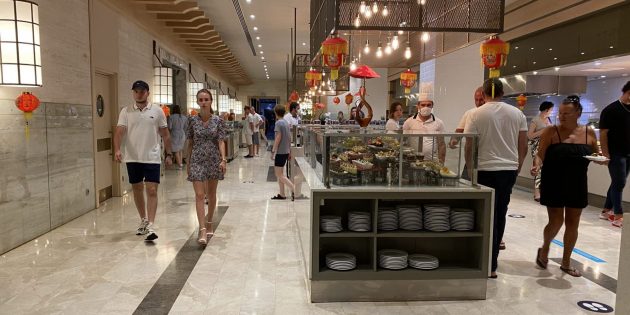
Photo: Irina Salamakhina
It would seem that with such a system queues are inevitable. However, my hotel did an excellent job rotating staff on time. Which, however, did not exclude the grumbling of vacationers in the spirit of “Am I supposed to walk with my hand outstretched?”
Some other changes have been noticed:
- At the entrance to the restaurant there is an antiseptic and a reminder about distancing.
- Cutlery is laid out on tables in plastic packages.
- The tables are spaced further apart.
- Watermelon swans and melon castles are a thing of the past.
- In the beach bar and à la carte restaurants you can view the menu using a QR code.
- It has become more difficult to get into à la carte establishments: the number of tables has been reduced, but there are still many people interested.
Animation and leisure
In terms of entertainment, the hotels offer everything: swimming pools (indoor and outdoor) and water parks, spas, hammam and sauna, fitness room, table tennis, billiards, and so on.
True, everywhere, except for swimming pools and water slides, they now ask you to sign up in advance: after all, the employees need to have time to process the inventory and equipment after each person.
Photo: Irina Salamakhina
It's the same with animation. The only thing is that hotels have abandoned mass discos and foam parties. Instead, they often hold live music concerts and performances by dance groups, seating spectators as far away from each other as possible. Daytime water aerobics and yoga classes have no shortage of participants. When entering children's clubs, it is recommended to wear a mask on the child - and perhaps that is why the children's room in the hotel was permanently empty.
When and where does it grow?
The habitat depends on the type of tinder. Thus, the sulfur-yellow (conditionally edible) tinder fungus prefers places with a mild climate. But the real tinder fungus is widespread throughout Russia and Europe. It loves to grow on birch and pine trees, and can also be found on alder, oak, beech, and other trees.
On the one hand, saprophyte negatively affects the environment. Causing white rot in wood tissue, it makes it brittle. It usually affects dead wood, since the main way of infecting a tree with tinder fungi is:
- broken branches;
- cracks and other damage in the bark.
It is recommended to collect polypores for pharmaceutical and food purposes:
- during spring sap flow;
- In the fall, the mushroom, preparing for winter, stores up useful substances.
You should not take tinder fungi:
- growing on dead wood;
- growing near the ground.
Preferably mushrooms located as high as possible. Mushrooms are cut with a well-sharpened knife or ax. If the mushroom body crumbles, it is not suitable for collection.
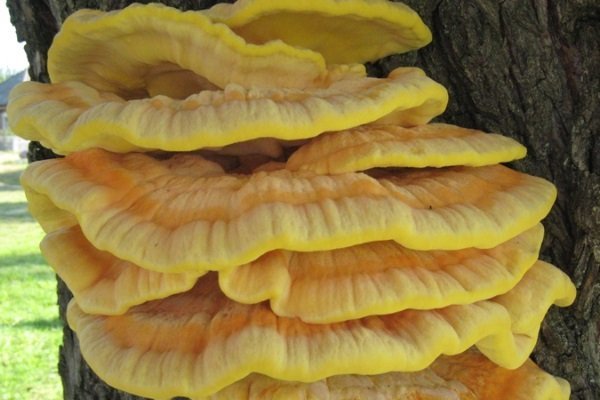
Kinds
There are more than 1.5 thousand species of polypores, here are some of them:
Larch (real)
Found on larches, cedars and fir. It is distinguished by a thick fruiting body up to 30 cm long, yellow or white in color, with a rough surface, rounded edges, grooves and brown areas. At first it is soft, but later becomes hard and crumbly. This mushroom tastes bitter. In the past, such a mushroom served as a raw material for tinder production. It often grows on dead deciduous trees and dead wood. We discussed the larch tinder fungus in detail in another article.
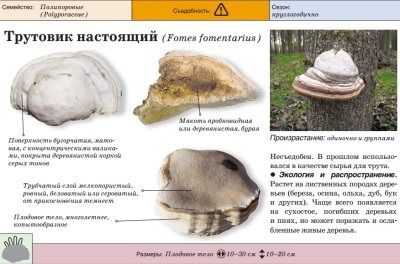
Flat
This mushroom has flat caps up to 50 cm in diameter, which have uneven ridges and a matte brown crust. It is found mainly on birch trees (less often on coniferous trees) - on dead wood and stumps.
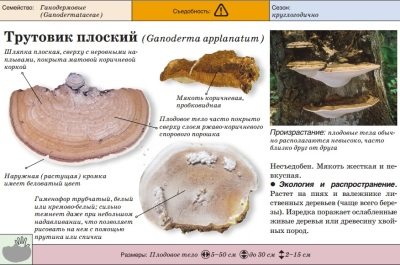
Lacquered (reishi)
It is distinguished by a reddish-brown shiny cap, the presence of a stalk and medicinal properties. Another name for this tinder fungus is reishi. Read more about it in another article.
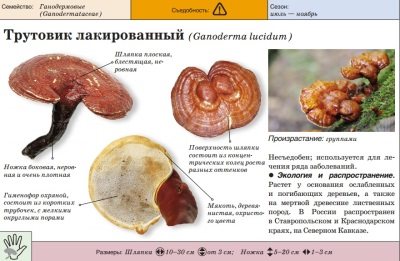
Umbrella
It has flat, light, rounded caps pressed in the center, collected into large fruiting bodies up to 40 cm in diameter and weighing up to 4 kg. This is a very rare tinder fungus, listed in the Red Book.
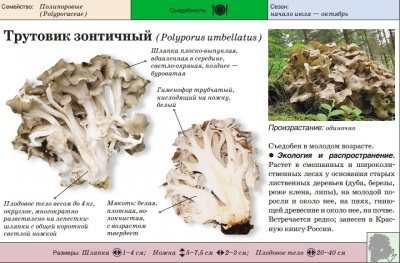
Sulfur yellow
The peculiarity of this type of tinder fungus is the yellow-orange color of its fruiting bodies. This mushroom reaches a diameter of 50 cm. It grows on weakened or dead trees in gardens, parks and forests.
Winter
It is distinguished by flat-convex yellow-brown caps, hard gray-yellow legs, and elastic flesh. Grows on roots, stumps and trunks of deciduous trees. Fruits from May to December. Edible when young.
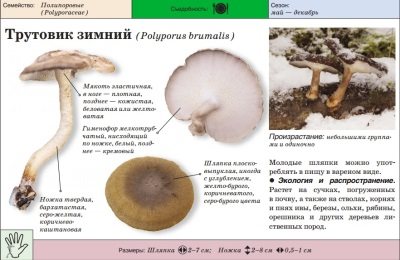
Stubble-haired
A special feature of this tinder fungus is the triangular cross-section of the fruiting bodies. The young mushroom is spongy and moist, but later dries out and becomes hard. The diameter of the fruiting body of this tinder fungus is up to 25 cm, height – up to 35 cm.
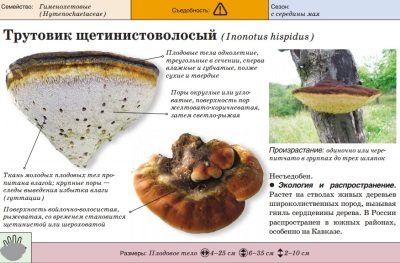
Chestnut
A mushroom up to 10 cm high with funnel-shaped light caps with wavy edges and hard legs tapering towards the base. Grows on dead wood and stumps in damp places.

Coarse-haired
These tinder fungi have semicircular sessile caps covered with hard gray hairs about 5 mm long, growing vertically in tufts. This species is found on deciduous trees - on trunks, dead wood, branches and stumps. Occasionally grows on wooden buildings and fences.
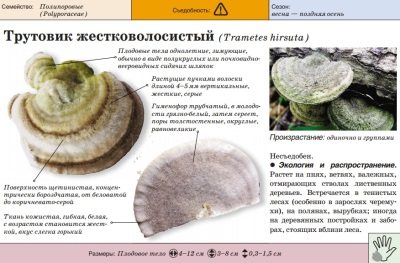
Birch
A mushroom with a smooth whitish surface, spherical fruiting bodies and white flesh, which has a distinct mushroom smell and bitter taste. This tinder fungus grows only on birch trees. At an early age it can be eaten. This tinder fungus contains polyporenic acid, which has anti-inflammatory activity.
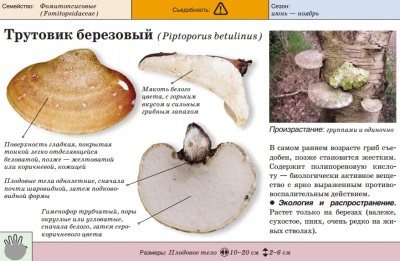
Radiant
It is distinguished by annual semicircular flat bodies with a wrinkled surface of a yellow-orange hue (later brown), which grow in rows or tiers on dead and living hornbeams, aspens, lindens, birches and other trees.
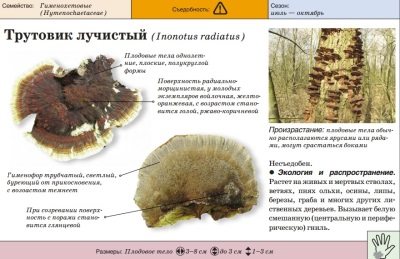
Multicolored
A special feature of this tinder fungus is the velvety surface of the fruiting bodies with concentric zones of different colors - from yellow to brown-blue. This mushroom grows in groups on stumps and dead trees (usually deciduous).
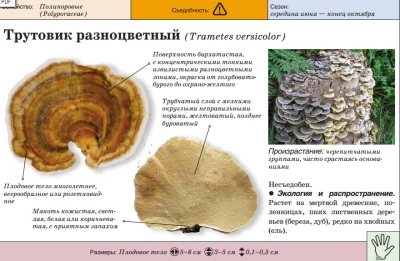
Scaly
This mushroom has open, light, fleshy caps up to 30 cm in diameter, elastic, dense flesh, and eccentrically located legs. This tinder fungus grows in parks and forests on weakened and living trees (often on elms).
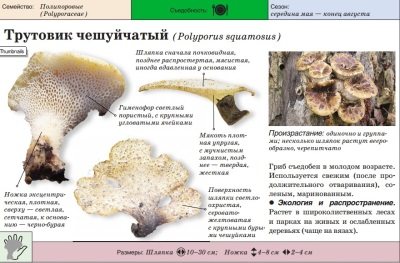
Cinnabar red
It is distinguished by hoof-shaped annual fruiting bodies up to 10 cm in diameter with a bumpy red surface and red flesh. Found on rotting and weakened deciduous trees.
